Let’s talk about the power of social proof in search advertising.
But I’m not going to bore you with examples of generic social proof in action.
By generic, I mean:
- “I love this product! – Sarah K.”
- “Recommended by Experts”
- “Every Editors’ Favorite [insert product type here]”
Nothing wrong with these of course in the sense that they are social proof signals – they’re just terribly bland and generic. A half-baked interpretation of the concept of social proof, if you will.
So in this edition of SERP monster, we’re going to find real-life ads in the wild – and show you exactly how to increase the social proof factor to 10, step-by-step.
But first, let’s jump into some background theory.
What Is Social Proof?
At its core, social proof is a bit like the saying “monkey see, monkey do”. It’s the idea that when we’re unsure about something, we look to others for cues on how to act. If everyone else is doing it, it must be the right thing to do.
This isn’t just a human quirk – it’s a survival instinct that dates back to our caveman days. Back then, conforming with the group was often a matter of life and death. If everyone else was running from a saber-toothed tiger, you’d have no choice but to be sprinting too.
Fast forward a few millennia, and that same instinct is still going strong. Only now, instead of predators, we’re navigating the wilds of purchasing decisions and social situations. And just like our prehistoric ancestors, we rely on social cues to guide us through the uncertainty.
And brands know this.
Types Of Social Proof
Social proof comes in all sorts of shapes and sizes, but specifically for search ads the below are most common:
- Testimonials and reviews
- User-generated content
- Expert endorsements
- Celebrity endorsements
- Trust badges and certifications
There’s not one that generally performs better than others for search ads, but here’s a tip: try and keep to one type of social proof signal per ad when starting out. That way, you’ll quickly get a gauge of which signals resonate best with your audience, and can double-down from there.
Social Proof Mistakes To Avoid
So we’ve established that social proof is a powerful psychological force. But there are also rules to be mindful of when employing social proof tactics across your search ads.
Social Proof Mistake 1: The Generic Experts Claim
You’ve seen something like it before – an ad that boldly declares, “Used by the world’s best dermatologists and facialists”. But who are these so-called experts? Are they legitimate authorities in the field, or just a bunch of actors in lab coats?
Given word count limits, sometimes you have to be a bit vague in your ad headlines. That’s fine, as long as you can back up your vague statements in the ad descriptions.
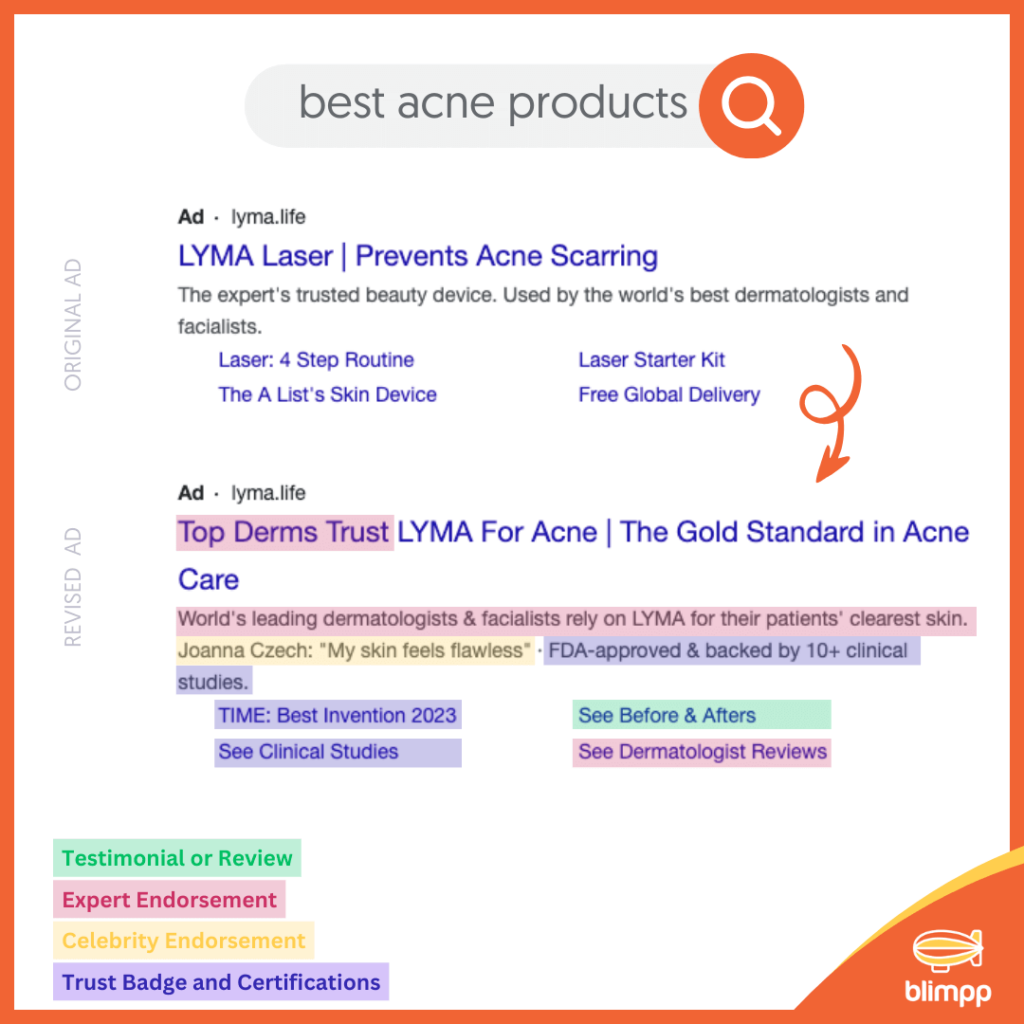
For LYMA, they actually have some pretty impressive testimonials on their website, from legitimately respected names in the skincare industry. Use them.
- Expert Endorsements: Position the claim as [expert] trusts [brand] to deliver [relevant outcome based on search query]. Double-down on this in the first description, so it’s absolutely clear what the claim is.
- Celebrity Endorsements: Ideally, they’re a known quantity for your audience (in a good way). Even if they’re less well-known, they still add weight to the positioning of the ad.
- Trust Badges & Certifications: LYMA are FDA-approved, backed by numerous clinical studies AND their device was featured by TIME Magazine as the Best Innovation of 2023. It’s unreal that they’re not talking about this in every piece of copy.
Generic expert claims can actually backfire, making your ad seem less credible and trustworthy. If you’re going to use expert endorsements, make sure you follow up on the who (they are) and the why (they trust your product), tying it back nicely to the search query where possible (the relevant outcome).
Social Proof Mistake 2: The Vague ‘Award-Winning’ Statement Claim
You’ve seen it before – an ad that proudly proclaims “award-winning”, as if all awards are equal. Let me break it to Nutrafol: no one cares about award wins, unless:
- The awarding body is relevant to and trusted by the reader
- The award is recent (i.e in the last 18 months)
- The award is specific to the product’s category
- The award is tied to specific benefits or results that the reader can expect to experience (i.e. best supplement for hair growth).
But assuming all these things stand – they can do a lot, lot better than this:
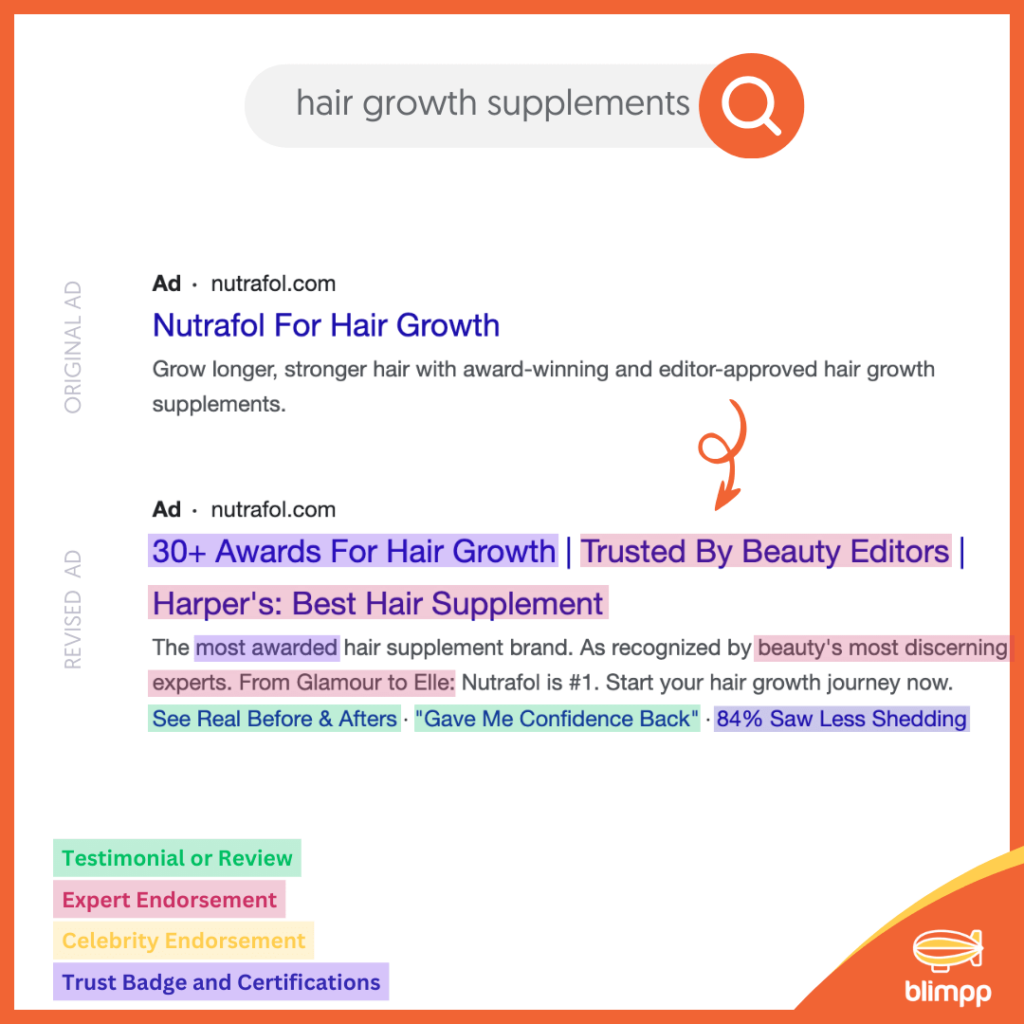
On a competitive SERP, you can expect to see “award-winning” bandied about at least 3 to 5 times. So it pays to be specific.
- Trust Badges & Certifications: Showcase the number of awards, assuming that it’s a competitive USP.
- Expert Endorsements: Don’t just claim ‘editor-approved’ – call them out by publication. Drop in a quote or award win where necessary.
- Testimonials & Reviews: Use sitelinks to mix up the social proof signals: showcase before and afters, customer reviews and clinical studies where appropriate.
When it comes to social proof, vague statements don’t really cut it. You need to be explicit about the claim. Provide context and credibility. Showcase the specific award(s) you’ve won and underline they matter to your target audience.
Social Proof Mistake 3: The ‘Science-Backed’ Statement Claim
“Scientifically proven!”. “Backed by science!”. These phrases are thrown around so often in ads that they’ve lost their impact. Without specific details about the scientific research or evidence, these claims can come across as hollow.
For example, take this ad from Seed Probiotics – if your label claim is that your product is backed by science, then show your receipts. Instead of a vague “science-backed” statement, provide specific details, like:
- Type of trial: For example, double-blind, randomized, placebo-controlled clinical trials.
- % Of Participants Positively Affected: For example, “78% of participants reported improved digestive regularity and reduced bloating”.
- Duration of Trial: For example, an 8-week study.
- Number of Participants: e.g. 300 women aged 30-65.
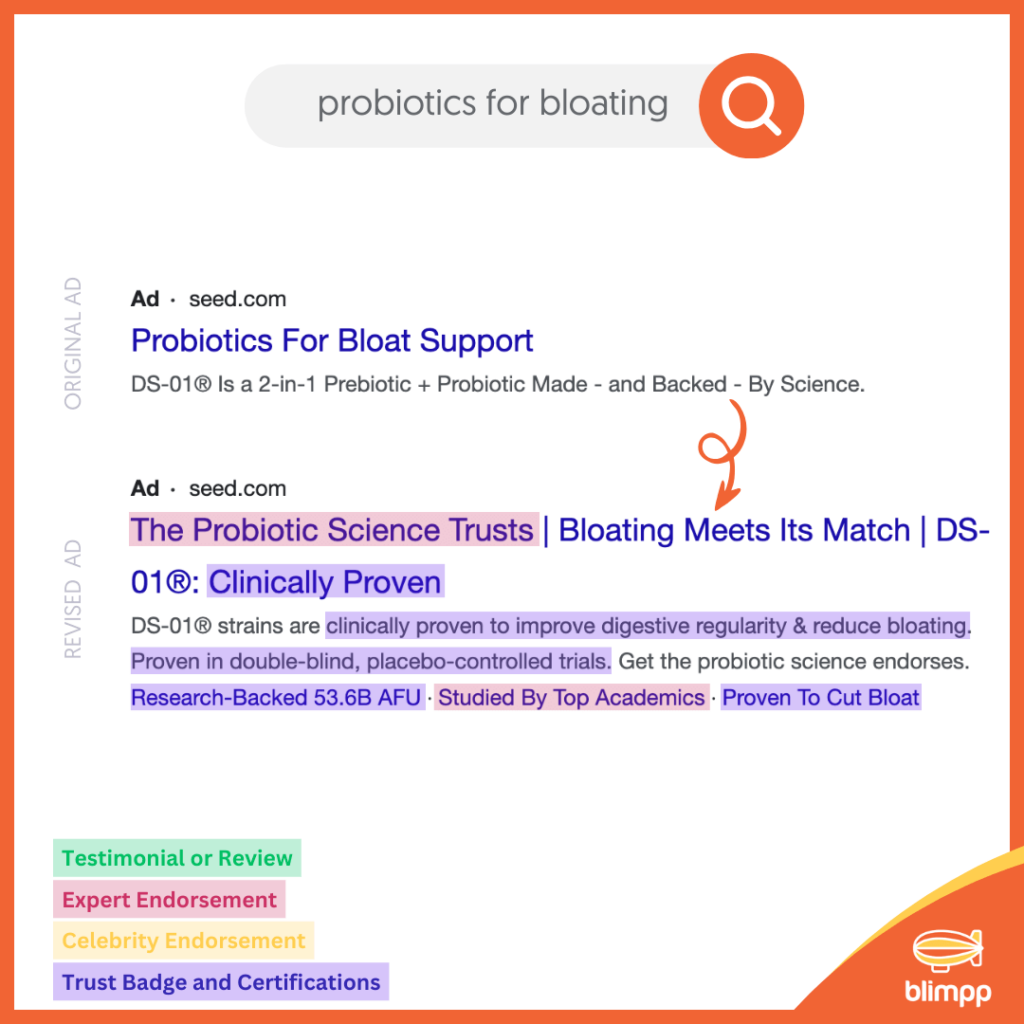
So here’s how we would crank up the science social proof signals on this one:
- Expert Endorsements: Rather than the overused “Science-Backed” use “The Probiotic That Science Trusts”. It incorporates the product category (useful to have in a H1), and also implies that the product is trusted by the science community, as opposed to backed by some scientific studies. There’s a difference.
- Trust Badge & Certifications: Show the science creds close up. Although ‘Clinically Proven” in the H3 is deliberately vague, we elaborate that it’s proven to improve digestion and cut bloating (in the first description), and then underline the type of clinical trial for good measure in the D2. Infinitely more descriptive of the rigorous process of becoming “science-backed”, than the original ad.


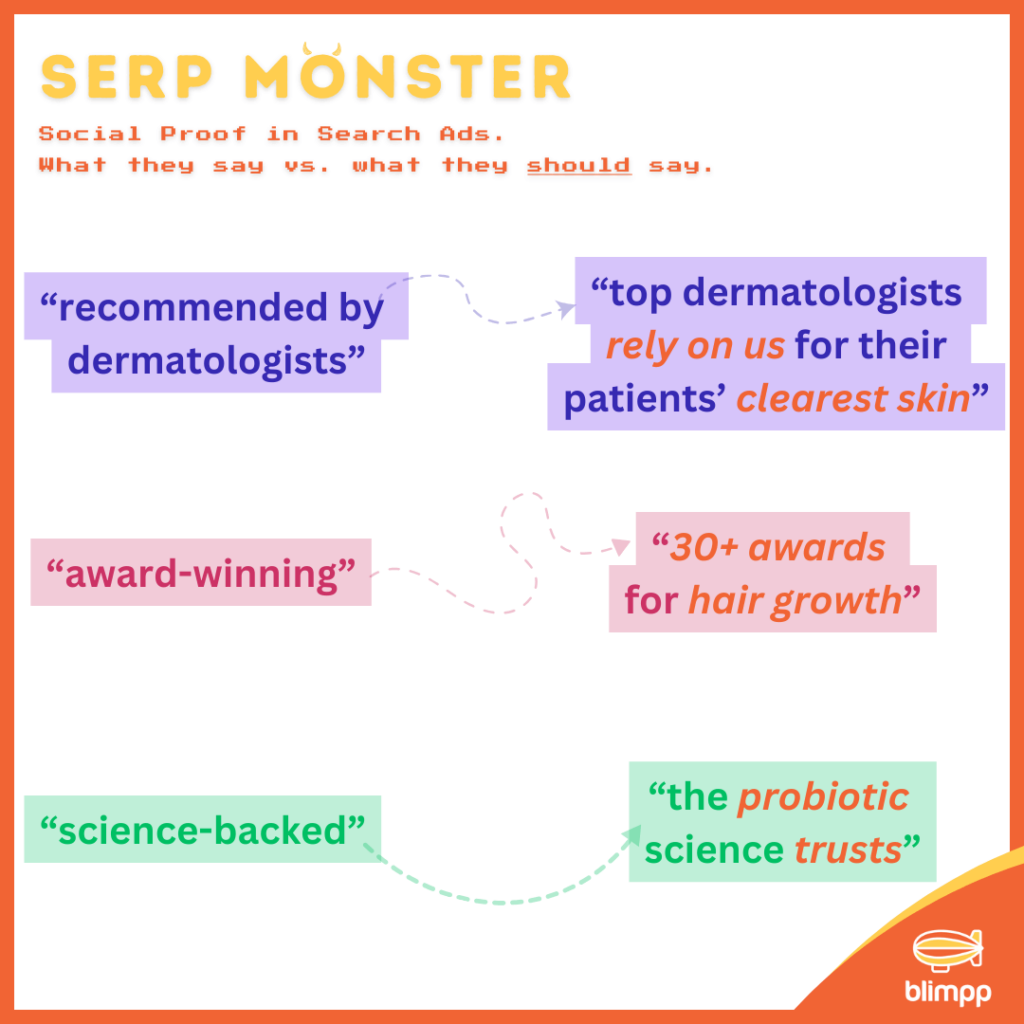
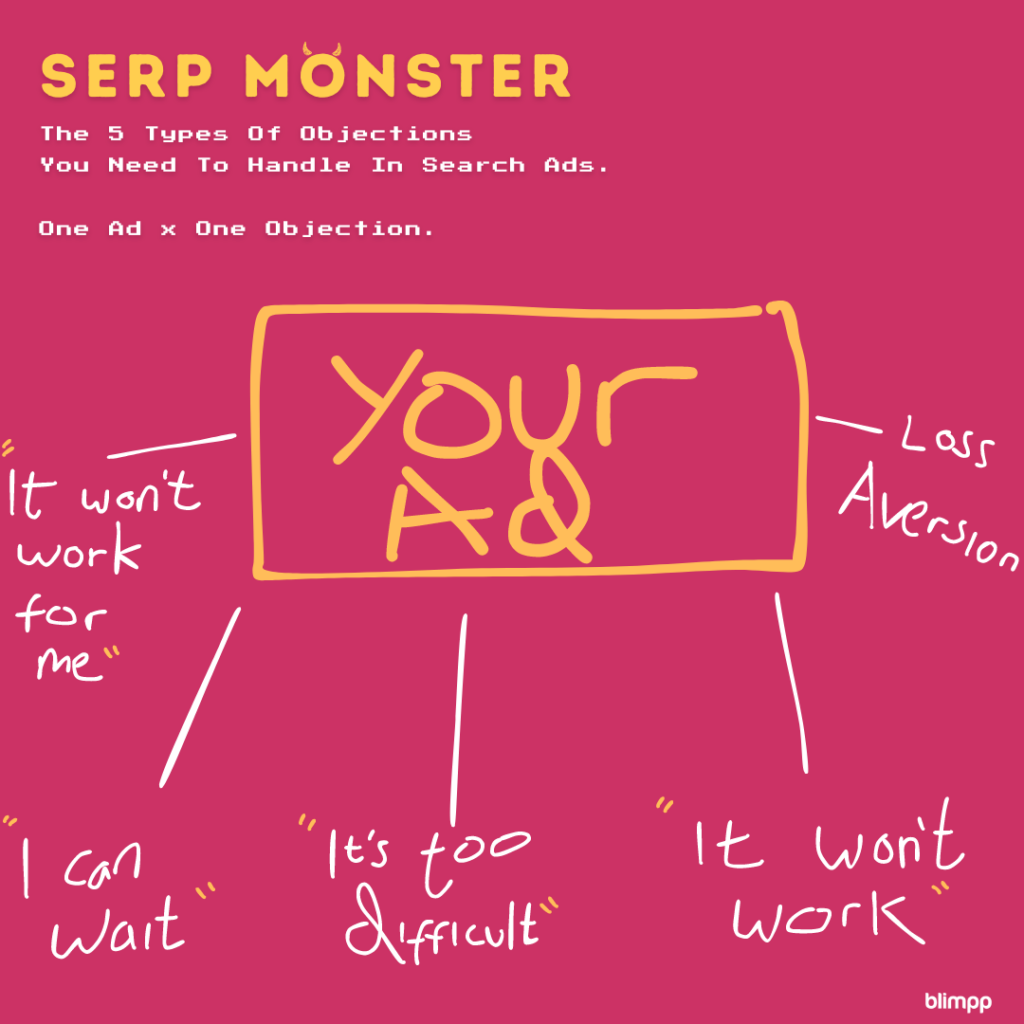
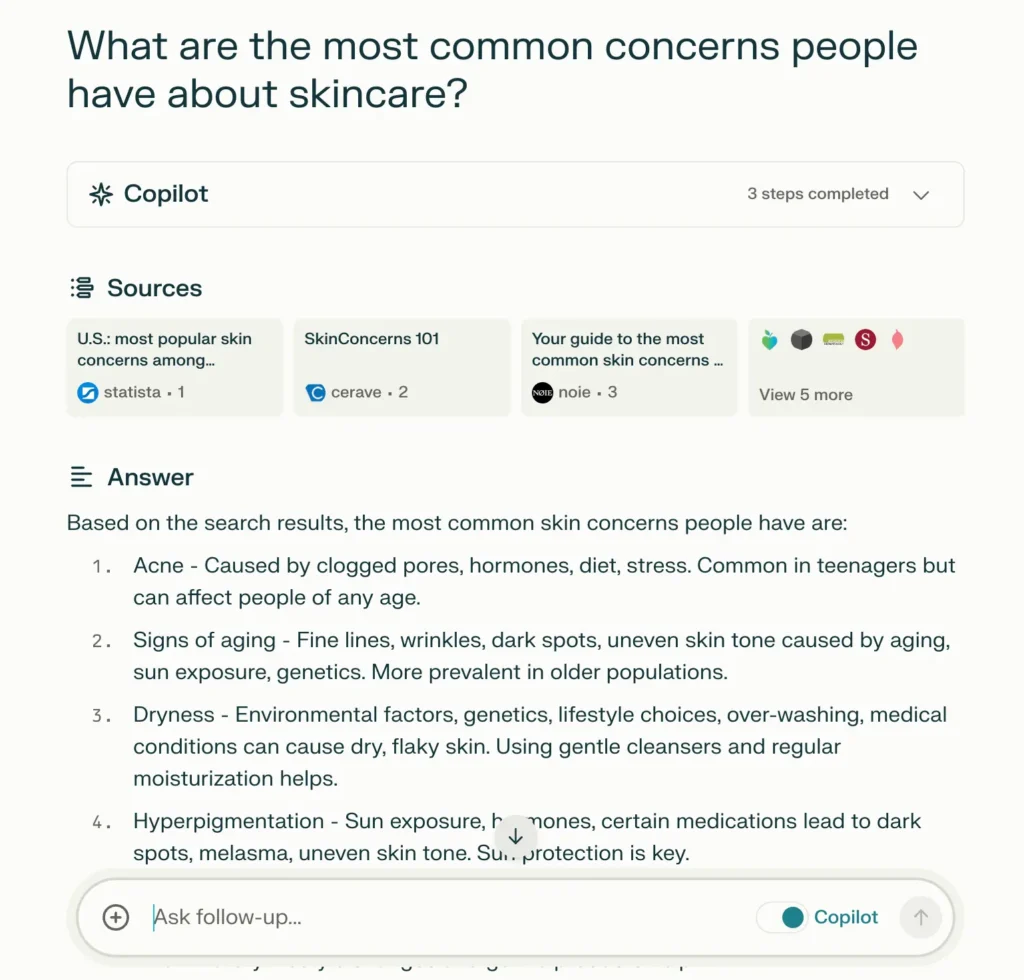

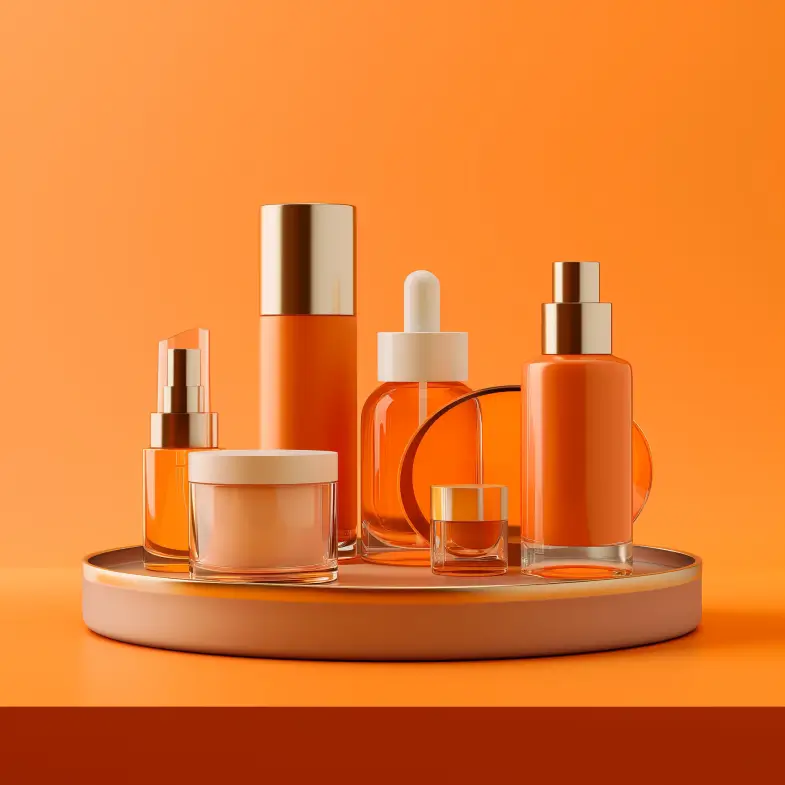


10 Responses
How do I gather social proof if I’m a new brand or have limited customer reviews?
If you’re just starting out or have a limited pool of customer reviews, don’t worry – there are still plenty of ways to gather social proof for your search ads. Reach out to your early customers or beta testers for testimonials and feedback. Offer incentives (like discounts or free trials) in exchange for honest reviews. Highlight any awards, certifications, or media mentions you’ve earned. Remember, even a few strong proof points can go a long way in building trust with customers.
Q: How do I choose the right social proof for my search ads?
A: Choosing the right social proof for your search ads comes down to relevance, credibility, and impact. When evaluating potential proof points, ask yourself: Is this proof point directly relevant to my target audience’s needs or pain points? Does this proof point come from a credible and authoritative source in my industry? Does this proof point demonstrate tangible value or drive a specific action? By prioritizing proof points that meet these criteria, you’ll be able to create ads that resonate with your target audience.
How do I fit social proof into my limited ad character count?
Fitting compelling social proof into the limited character count of search ads can be a challenge, but it’s not impossible. Focus on one strong proof point per ad, rather than trying to cram in multiple claims; use concise, specific phrasing that packs a punch (e.g. “Rated #1 by X Magazine”). And where possible, use ad extensions (like sitelinks or callouts) to show additional proof points.
How often should I update my social proof in my search ads?
Regularly updating your social proof is key to keeping your ads fresh, relevant, and credible. As a general rule of thumb, aim to refresh your proof points at least once per quarter, or whenever you have new and noteworthy proof points to share (like a new award or customer milestone).
How do I measure the impact of social proof on my search ad performance?
The key metrics to watch are Click-Through Rate (CTR) – are your social proof ads driving more clicks than your non-social proof ads? Conversion Rate – are your social proof ads leading to more conversions or sales than your other ads? Quality score – are your social proof ads earning higher quality scores and better ad rankings? Return On Ad Spend (ROAS) – are your social proof ads delivering a better return on your advertising investment?
How do I choose the right social proof for my search ads?
Choosing the right social proof for your search ads comes down to relevance, credibility, and impact. When evaluating potential proof points, ask yourself: Is this proof point directly relevant to my target audience’s needs or pain points? Does this proof point come from a credible and authoritative source in my industry? Does this proof point demonstrate tangible value or drive a specific action? By prioritizing proof points that meet these criteria, you’ll be able to create ads that resonate with your target audience.